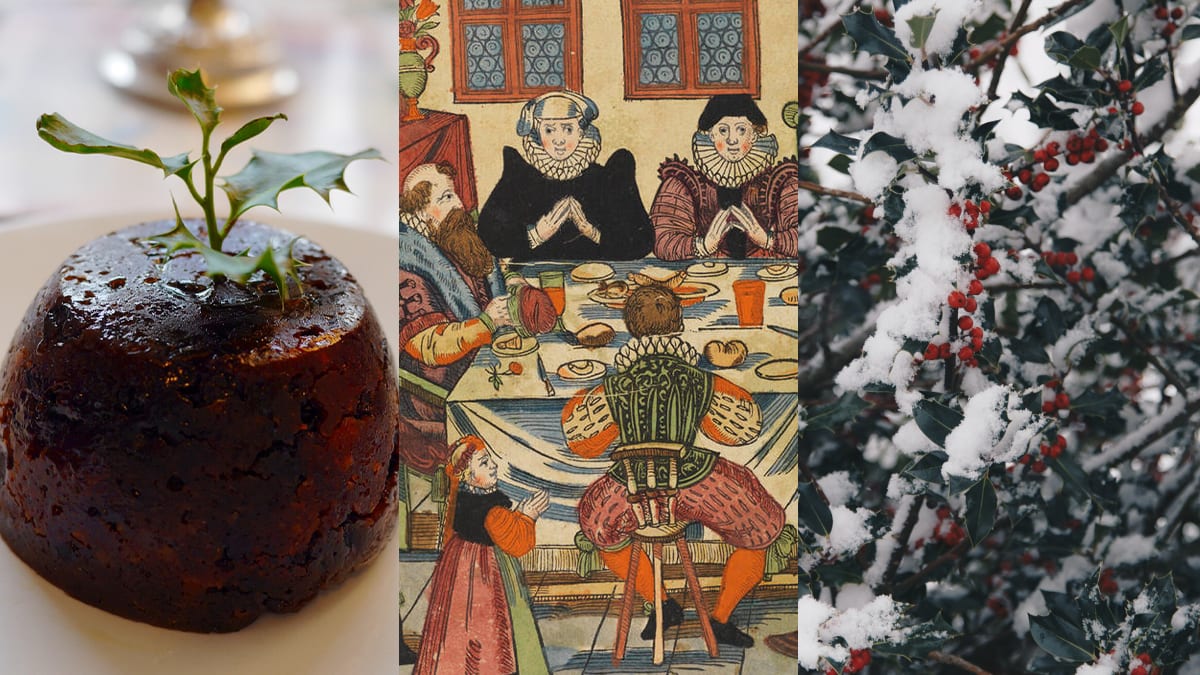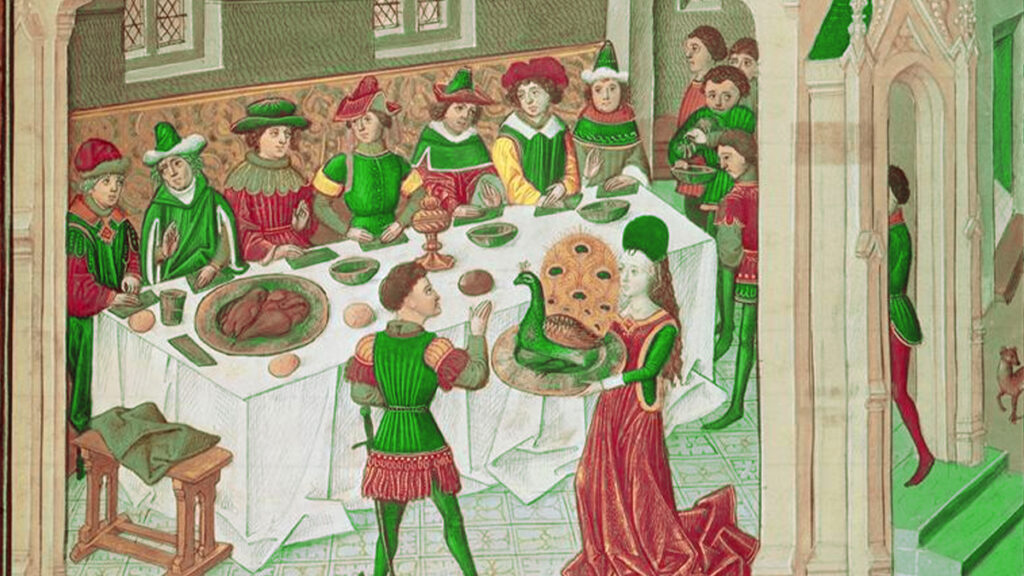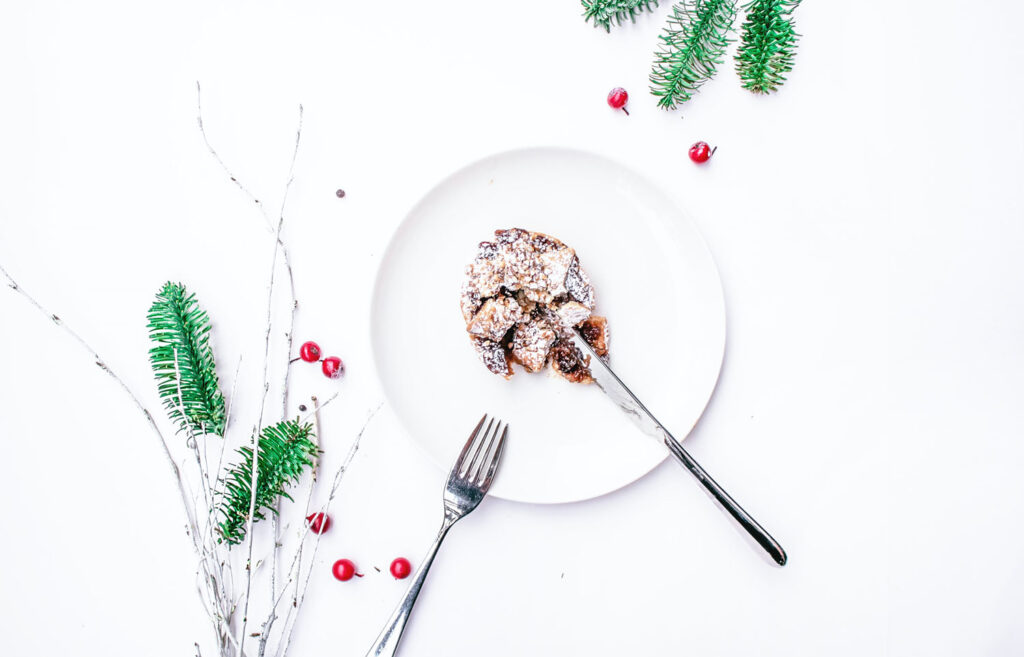

For as long as I can remember, I have been OBSESSED with the medieval era. When I was a kid, my grandmother got me these books called “Horrible Histories,” and I remember pouring over them again and again! Whenever I visit a museum or art gallery, the medieval section was the first place I was drawn to. When writing this series on Christmas Traditions around the world, one of the first things which got my curiosity peaked was thinking about how medieval Europeans celebrated Christmas. “Did they even have Christmas back then?” I wondered. I sped off to the library to read more on the subject and was shocked by how many of our modern-day traditions have their roots in the middle ages! So next time you’re baking some gingerbread or having that big Christmas dinner maybe you’ll think about how ancient some of these concepts really are.


If you grew up with English grandparents, you surely had mince pie on the Christmas table every year. Every Christmas dinner, my grandmother would bring out these tiny mincemeat pies, and I would watch questioningly as my family would gobble them up. I would always pass and only in the last few years have I grown a fondness for them.


Mince Pies are one of the oldest traditions from midwinter festivities. They were meant as a way to re-use shredded meats from banquet leftovers like goose, chicken or beef. The pies were filled with fruits and spices to perhaps mask the smell and taste of the slightly-off bits of meat. The addition of meat in the dish was removed in the 1800s and it became much closer to the sweet dessert we know of today.
While having a turkey as the centrepiece of our Christmas dinner is now the norm, this wasn’t the case in the medieval period. But the idea of having a bird as the main course does pre-date our modern-day meal. In medieval celebrations, birds were served at the banqueting table in most wealthy households. But unlike our roast turkeys, these birds were served to look like they were still ALIVE! The animal was skinned, then roasted, and a replacement skin was then sewn back onto the meat. This was done so that the meat looked like it was being served from a living bird. Medieval kings and queens loved spectable and this was the height of food-for-entertainment.
The peacock was thought to the most prestigious of these creations as their feathers would bring awe to all the guests present. Smaller households were inspired by the royal’s love of serving these birds, and they would serve a simple goose. Many people still eat goose for their Christmas dinner, and I highly recommend it! It’s very fatty but as it’s small it is perfect for a household of only two or four.
If you don’t have turkey on Christmas, you might have a large roasted Christmas ham. The tradition of eating pork during the Yule time celebrations goes all the way back to the middle ages. Still, instead of meat from the hindleg, they would dine of the boar’s head! This tradition is thanks to the Vikings, who would sacrifice a boar to the god Frey during the Yuletide. Frey was known to ride a great gold-bristled boar Gullinbursti. As Frey was the god of fertility, rain, and sunshine, it was thought that this sacrifice would be a good fortune and a healthy harvest to the people.
Eating a boar’s head became even more popular across Europe when it became a popular part of a Christmas carol. The “Boar’s Head Carol” is a 15th-century English Christmas carol that describes the ancient tradition of sacrificing a boar and presenting its head at a Yuletide feast. As the boar’s head is perhaps not the most nourishing part of the animal, the traditions eventually turned into what we now know as the roast ham.
I have a winter hat in the shape of a Christmas pudding, and it’s by far my favourite thing to wear the second it becomes acceptable to wear Christmas-themed clothing in December! Plum pudding is a dish that is most popular in the UK, but eating such desserts dates back to England’s medieval ancestors. The pudding’s original version was actually more like a porridge, made from beef and mutton with raisins, wine, and spices added. It was pretty soupy, but breadcrumbs were added to give it some additional thickness. Sounds pretty unappetizing, but during the solstice, when poor families struggled to find something warm and hearty to eat, it was considered a luxury. Although the recipe has been refined over time, eating plum pudding on Christmas Eve still makes you feel warm and fuzzy inside!
Some people have the tradition of hiding something inside the pudding. You hid a silver coin, small crown or ring inside the dish before baking. Whoever has the piece of pudding with the treasure inside their slice would be known as the King or Queen of the dinner. The finding of the metal was thought to bring the receiver good fortune for the year to come. Just be sure to use a food-safe material!
It seems that no matter where you live in the world, you have a warm, spiced drink which simmers on the stove during the holidays. In England its mulled wine, in Mexico Ponche, in Sweden Glogg and so on! But all these drinks date back to the medieval Wassail. Wassail was a drink made from hot mead or mulled cider. It was one of the most important things to bring with you during any Yuletide festival. Pagans would bring their wassail bowl, full of the beverage, to the tree of worship. They would proceed to pour the alcohol over the roots of a great apple tree in the hopes of ensuring a good harvest the following year. There is even an ancient Christmas carol all about Wassail.
Wassail! Wassail! All over the town, Our toast it is white and our ale it is brown; Our bowl it is made of the white maple tree; With the wassailing bowl, we’ll drink unto thee.
Wassail is actually delicious and super easy to make. All you need is 1/3 pint apple cider (or apple juice if you can’t find cider), zest one lemon, 1/8 tsp nutmeg, 1/4 tsp cinnamon, 1/4 tsp ginger, 1 oz sugar, 1-pint ale (or omit if you prefer an alcohol-free version) and 1 tsp honey. Simmer on the stove till the scent of apples and spices fill your entire house with festive fragrance.
During the cold and dark winters, the idea of bringing greenery into your house was a popular medieval tradition. The idea of seeing these green boughs was meant to symbolize life during a season when everything else seemed to be dying. While the outdoors was barren and grey, your home was not. Even the most impoverished household could go out and collect greenery to decorate the house, so its popularity was wide-ranging. Two of the most popular plants to collect were holly and ivy. Since they had roots in Saturnalia’s pagan festival, the church widely disapproved of this kind of decoration. But the people persisted with it nonetheless. Holly is one of the oldest good-luck charms used by ancient Celtic druids to ward off evil spirits. It was thought to also protect the home from lightning and was used for good luck.
Mistletoe is another plant that has been used in Christmas celebrations for ages. It was long thought to be used as an ancient cure-all by the druids. People would use it for fertility, to protect their crops and even to ward off witches. The mistletoe myth of bestowing love upon any couple who kiss beneath it dates back to the Norse gods. The Norse god Balder was thought to have died after being killed with a spear made from the mistletoe. His mother, Frigg, wept upon finding her son dead, and her tears turned into the white berries on the plant. Frigg ensured that whenever a couple met under the mistletoe, she would protect them in a way she could not have saved her son. And instead of becoming known as a deadly plant, it was known as the plant of love.
The idea of kissing under the mistletoe comes from England, when servants were allowed to steal a kiss from any woman under the mistletoe, and refusing was seen as bad luck. Another tradition goes that you must kiss once for every berry on the mistletoe and pluck them as you go until all the berries are gone.
In medieval times, druids were known to worship oak trees. This enraged many early Christians, including St. Boniface, who despised their love of the great tree. One day St. Boniface headed out to the great oak and cut it down. When it fell, a fir tree grew up from its roots. Boniface proclaimed that this fir tree symbolized Christ, as its branches never turned brown, a symbol of Jesus’s eternal life. Being amazed at the sight, many of the druids decided to finally convert to Christianity.
The earliest known decorated Christmas tree was noted in 1419 in Freiburg, Germany. The Baker’s apprentices decorated a tree outside the local hospital with apples, wafers, gingerbread, and tinsel. They decorated it at Christmastime to bring joy to those suffering inside whenever they looked out their window.
Pagan and Norse people would perform a yearly ritual to appease the god Thor. They would place a log in the hearth, and if the log burned all throughout the Yuletide celebrations, this would ensure the sun’s return. Often, they would dose the log in alcohol to ensure it burned for a long time. When paganism was replaced with Christianity, this tradition continued as the log was seen to represent the warmth that Jesus brought to humanity on Christmas Eve.
As the hearth slowly was replaced with modern electric technology, people continued leaving out a log on their dining table as a symbol. Eventually, someone had the brilliant idea to turn the symbol of the Yule Log into a delicious dessert, as it’s much more enjoyable to eat rather than just staring at a log on the table.
Many people credit St. Francis of Assisi with the invention of the Christmas Carol. In 1224, during one of his nativity services, Francis led the crowd in a song of praise for the baby Jesus. His joyful tunes caught on with the group, and they would excitedly gather every year to take part in the singing. Eventually, the tradition of singing happy tunes around the holiday season caught on, and now it is one of the most popular traditions for families to take part in during large gatherings. These melodies weren’t always necessarily religious during medieval times and sometimes just focused on the winter season.
One of the most popular winter activities during the winter in the middle ages was sliding on frozen lakes. People would use the large bones from a horse to strap to their feet. They would then use long poles to help themselves glide along the frozen water. This was one of the earliest forms of ice skating, a tradition that many families love to partake in every Christmas.
Before there ever was Santa Claus, there was St. Nicholas, better known as Father Christmas. St. Nicholas was born in 280 in Patara, now Turkey. Three girls in his local village were on the verge of being sold into slavery or prostitution by their father. The family was too poor to afford a dowry and I guess back then it was get married or be a prostitute? No fun…
Upon hearing this, St. Nicholas snuck out and dropped a sack of gold coin through the window. He would place the coins inside their drying socks left by the window (where we get the traditions of hanging stocking today). This gift meant their father could afford a dowry, and they would be spared from being sold off. Nicholas became the patron saint of charitable fraternities and guilds of unmarried girls.
To honour his charity, in the 12th-century French nuns began secretly leaving presents inside the homes of poor children. They would always do so on the eve of Saint Nicholas. Soon the trend of secret gift-giving in honour of Saint Nick caught on all around Europe. There were even marketplaces that would pop up around the Yuletide dedicated to selling toys and treats for children.
Royal winter feasts were something for the history books. In 1213 it was recorded that at King John’s Christmas feast, the cooks ordered 24 hogsheads of wine, 200 head of pork, 10,000 salt eels, 1,000 hens, and 500 lbs of wax, 50 lbs of pepper, 2 lbs of saffron, 100 lbs of almonds! Truly one of the most extensive grocery shopping trips of all time I’m sure!
But even for more modest households, the Christmas feast was still a massive event during the Yuletide season. The meal’s principal components were hearty meats, cheese, bread, ale, and a table of sweets. Venison was the most popular meat to be eaten at the time, along with pork & rabbit for the rich. The poor, on the other hand, ate sausage and bacon. Candied fruit, sugared almonds and sweets have always been popular Christmas treats.
Whether baked in the shape of little men or made into a large house decorated with candies and icing, gingerbread is one of the most iconic Christmas foods! But the history of this dessert dates all the way back to the 11th century. It made its appearance during the Crusades when ginger was brought back from the Middle East. Back then, ginger was one of the most expensive spices. Using it in dishes was a means to show off your wealth. The earliest recipe we have of gingerbread consists of stale breadcrumbs combined with flour, ground almonds, rosewater or powdered sandalwood. It was then mixed with sugar, and fresh ginger.
This paste was pressed in moulds and sometimes even covered in gold leaf. Those who couldn’t afford gold leaf would use white icing sugar to decorate the shapes into more detailed reliefs. The shapes were used to tell stories from the news of the day. And sometimes, were made in the likeness of famous kings and emperors. In the 15th century in Nuremberg, the cookies became so popular and lucrative that an entire guild was dedicated to the profession.
While Marzipan is definitely not my favourite treat, it was a real hit with medieval aristocrats. The paste, made from almonds, sugar and egg whites, was an exotic treat. It made its way from Persia to Europe in the early 15th century. Back then, it was considered a luxury and often given as a Christmas gift. In addition to the wonderful almond flavour, Europeans loved the aesthetics of the dessert. It could be formed into many different shapes and painted to look like extraordinary creations. They loved giving the gift of surprise more than anything else. It was always a treat for them to reveal to the giftee that the music box or even the small bird in front was actually a sweet treat!
Boxing Day in medieval times was not a day for shopping. Instead, it was a day for the “reversal of fortunes.” During this time, the rich were encouraged to give gifts to the poor. Gifts were placed in boxes that employers would often give to their servants to reward them for their yearly service. Metal boxes were also placed outside churches to collect money and donations on the Feast of Saint Stephen, which took place on December 26th. St. Stephen was the first Christian martyr known for his charity acts towards the poor.
I hope you enjoyed this dive into the traditions of Medieval Christmas and maybe even consider adding some medieval flavours into your Christmas this year!
Paris transforms into a magical wonderland from November to January, bursting with festive charm and…
French cuisine is one of the coziest delights to savour in winter. With its hearty…
During the festive season, Paris becomes a sparkling holiday dream, with twinkling fairy lights cascading…
When it comes to Christmas shopping, Paris is pure magic—a city where elegance meets holiday…
There’s nothing quite like Paris at Christmastime—the City of Light transforms into a glittering wonderland,…
There’s something undeniably magical about Paris at Christmas. Sure, the City of Light is enchanting…
This website uses cookies.
View Comments
Loved your article! Any chance you are willing to share sources?